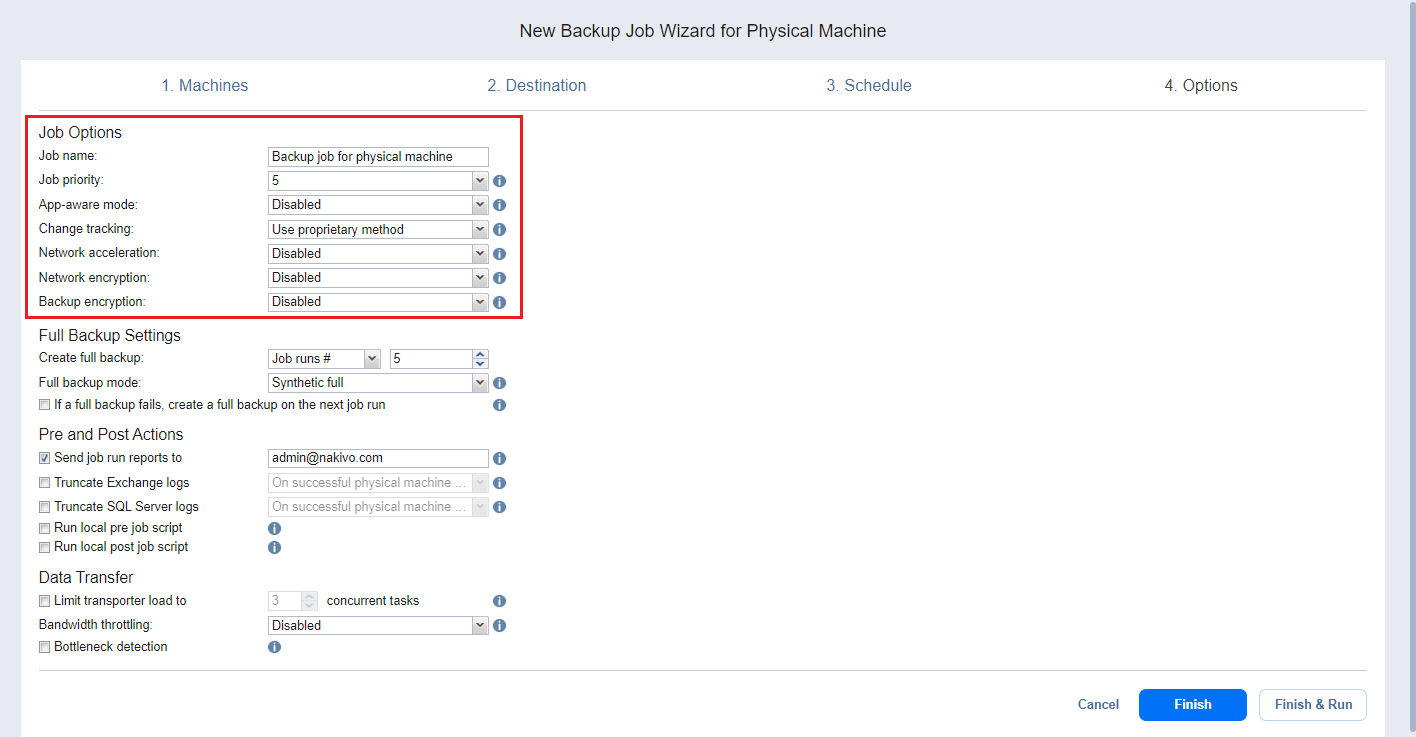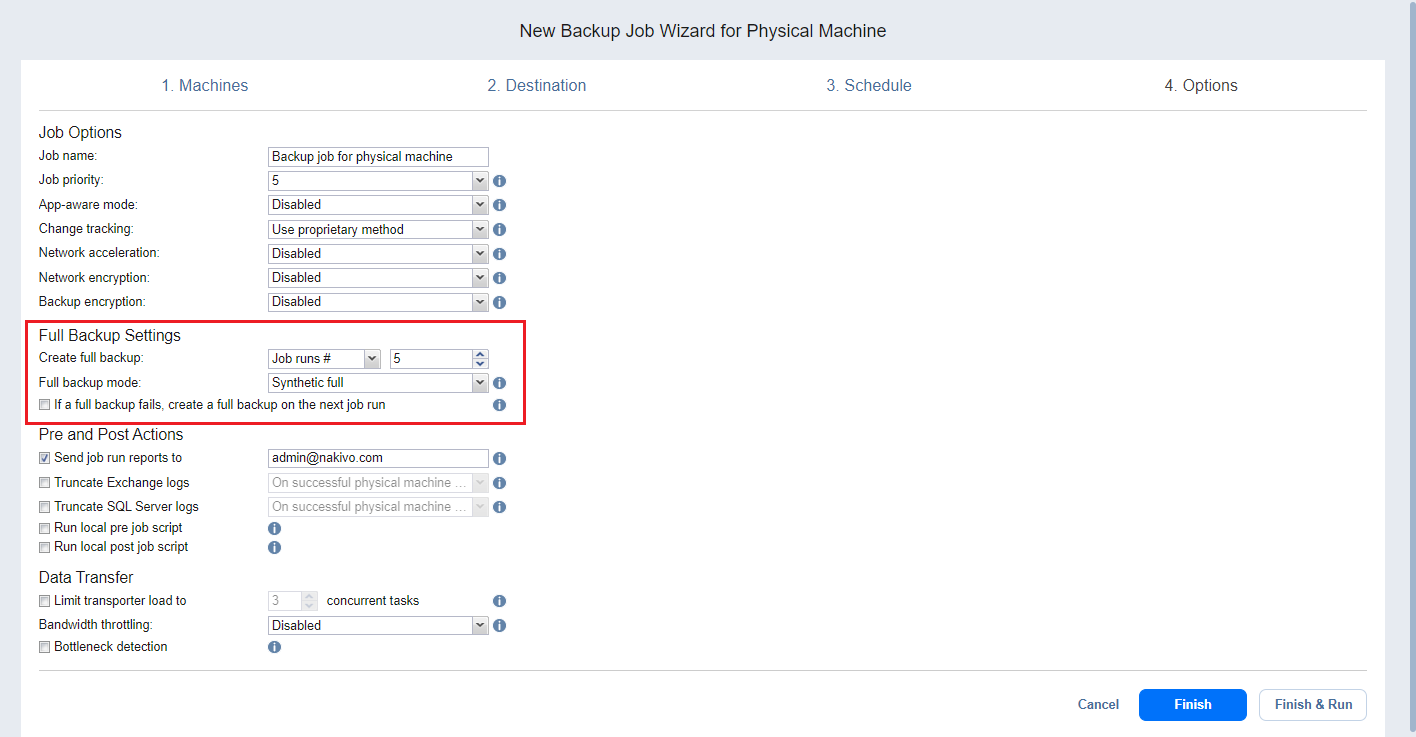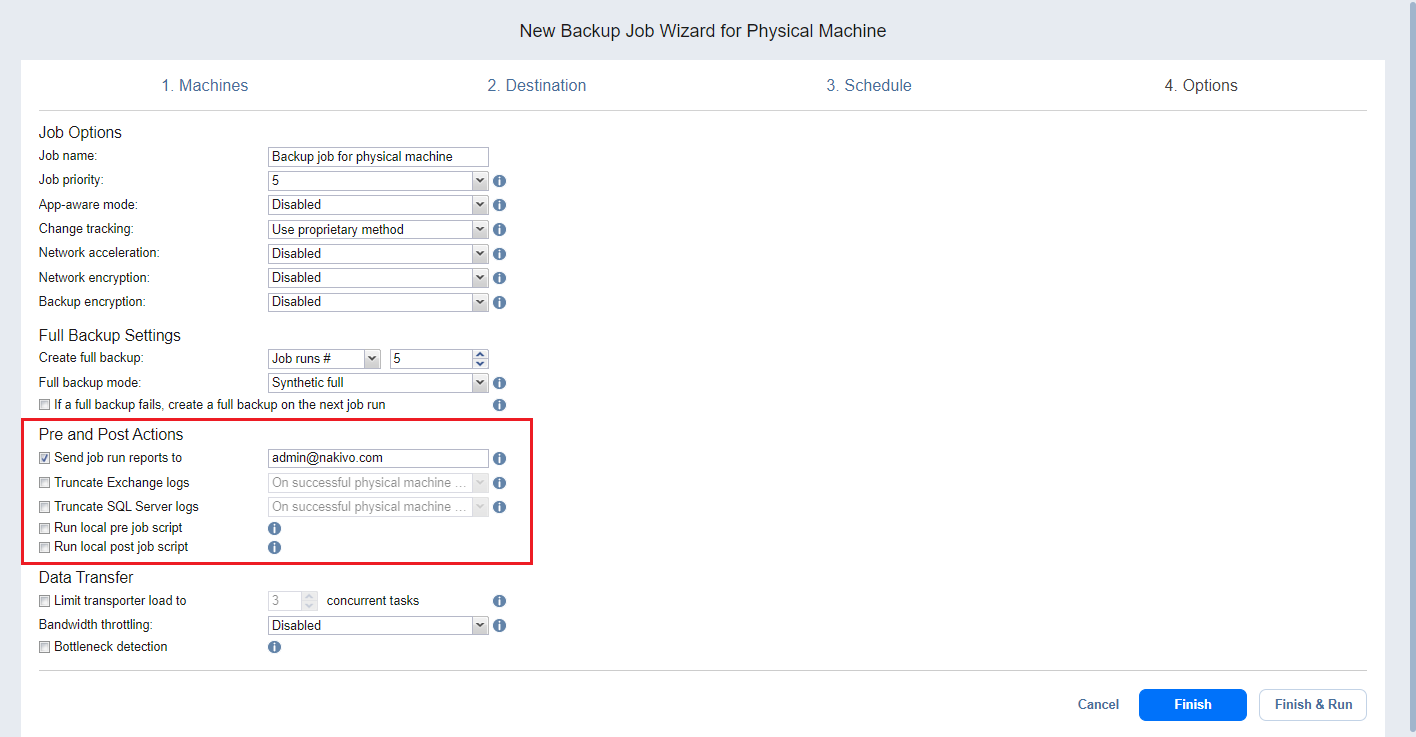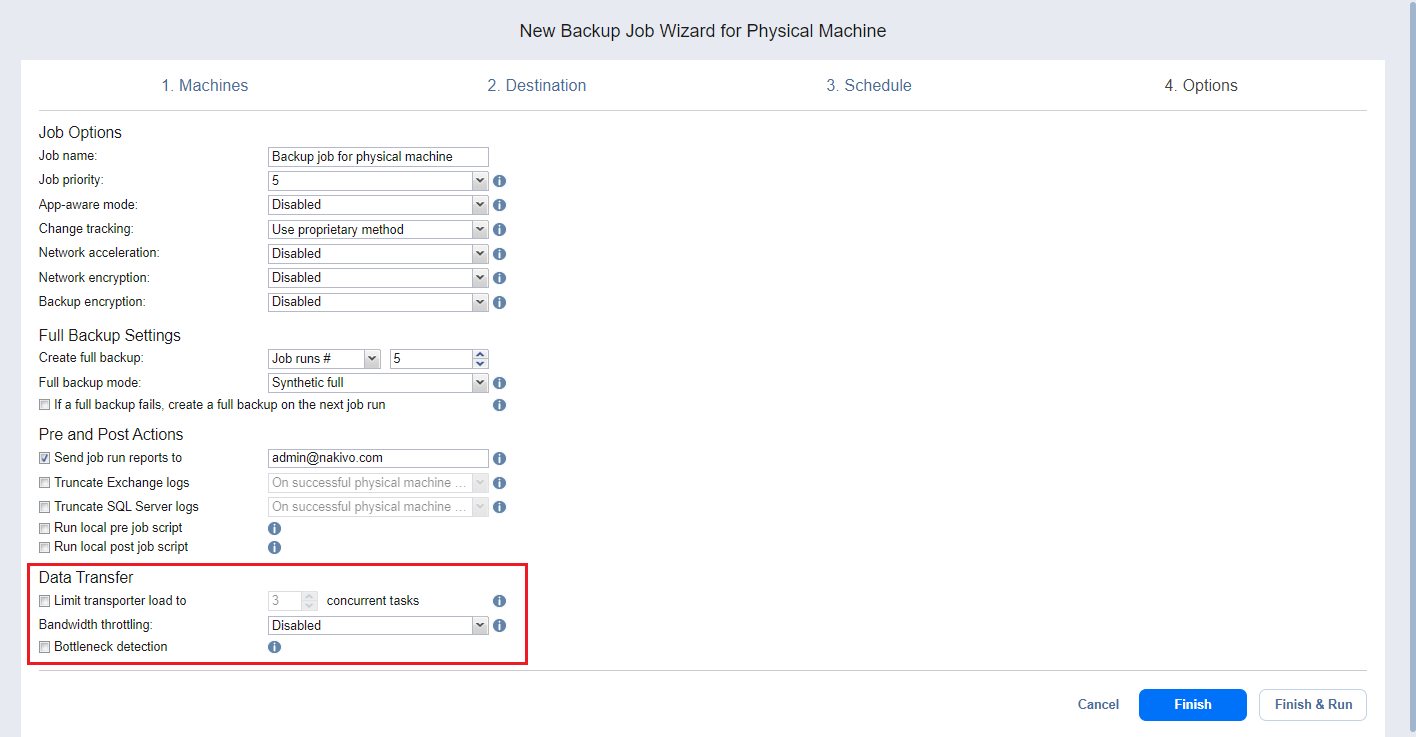Backup Job Wizard for Physical Machine: Options
On the Options page of the wizard, you can specify job options. Proceed as described in these sections:
Job Options
In this section, you can configure the following settings:
-
Job name: Specify a name for the backup job.
-
Job priority: Select a job priority level between 1 and 5, with 1 being the highest priority. Jobs with higher priority levels are prioritized by Transporters during job processing.
Note
This option is only available in the Enterprise, Enterprise Essentials, Enterprise Plus, MSP Enterprise, and MSP Enterprise Plus editions. -
App-aware mode: If the mode is enabled, machine processing is performed using guest OS quiescing to ensure that application data is consistent. Before enabling app-aware mode, make sure you meet the feature requirements for physical machines. In case of failure, the data gets automatically copied directly from source volumes. If the option is disabled, the product creates normal snapshots of source volumes.
-
Change tracking: Select one of the options from the drop-down list:
-
Use proprietary method: If this option is selected, NAKIVO Backup & Replication performs incremental backups using a proprietary change tracking technology. This feature requires the reading of contents of all VM disks to determine which data blocks have changed since the last job run.
-
No change tracking (always full): If this option is selected, NAKIVO Backup & Replication always performs a full backup of all source machines.
-
-
Network acceleration: Enable network acceleration if you transfer data over a slow WAN. Note that you need at least one Transporter on the source and target sites to enable network acceleration.
Note
The Network acceleration option is not available if the Backup encryption option is enabled.
-
Backup encryption: When enabled, backup data is protected with AES 256 block cipher encryption with a 256-bit key length. You can protect the backup file by creating a new password or selecting an existing one. For more information, refer to Enabling Backup Encryption.
Notes
-
This option is available only if the Disk or Tape destination type was chosen on the Destination page of the wizard.
-
The Backup encryption option is not available if the Network acceleration option is enabled.
-
If enabled, the created recovery points are encrypted.
-
The Backup encryption option is not displayed for a backup job where forever incremental repositories are selected as the only target repositories.
-
The Backup encryption option cannot be enabled if multiple targets with a mix of supported and unsupported (SaaS repositories or forever incremental repositories) repositories are selected as destinations.
-
It’s recommended that you enable the (AWS) Key Management Service. If KMS is enabled, all backup encryption passwords encrypted with the Key Management Service cryptographic key are available for recovery in case of product re-installation. For more information, refer to Enabling KMS.
-
Full Backup Settings
If the of the Backup Repository that you've selected on the Destination page of the wizard is set to Incremental with full backups (Store backups in separate files option is selected), you can specify the following options:
-
Create full backup: Specify how often full backups should be created.
-
Full backup mode: Specify how the full backup should be created. You can choose between the following options:
-
Synthetic full: If this option is selected, NAKIVO Backup & Replication will first perform an incremental backup (that is, will transfer only the data that changed since the last backup) and will then transform the available data into a full backup file. This approach has the following benefits:
-
The synthetic full backup is usually faster than the active full backup.
-
The load on the network is lower, as less data is transferred.
-
The load on the source datastores running your production machines is lower.
-
-
Active full: If this option is selected, NAKIVO Backup & Replication will read all VM data from the source datastore and transfer it to the Backup Repository.
-
-
If a full backup fails, create a full backup on the next job run: With this option selected, the next job run creates a full backup if the current job run fails to do so.
Pre and Post Job Actions
NAKIVO Backup & Replication provides you with the ability to enable certain actions before a backup job begins and after it has completed. You can choose to send job run reports, truncate Microsoft Exchange and SQL Server logs and run local pre and post job scripts.
Email Notifications
NAKIVO Backup & Replication can send email notifications to specified recipients on job completion status. This feature complements global notifications and provides you with the ability to configure notifications on a per-job level.
Note
To enable this option, configure your Email settings.
Truncation of Microsoft Exchange Server Transaction Logs
Microsoft Exchange Server database transaction logs record all changes in a Microsoft Exchange server database. Over time, these log files accumulate and can consume all of the available disk space if not removed periodically. NAKIVO Backup & Replication provides you with the option to delete (or truncate) Microsoft Exchange Server logs on the source machines after job completion.
The transaction logs are deleted after the job is completed so that the log files are available in the backup. Note that the product deletes only those transaction logs which are already committed to (available in) the Microsoft Exchange database.
To set up Microsoft Exchange log truncation, do the following:
-
Select the Truncate Exchange logs option.
-
Select one of the following options:
-
On successful physical machine processing only
-
Always
-
-
In the dialog box that opens, select the checkboxes next to the physical machines running Microsoft Exchange and then select the credentials next to each physical machine. These credentials will be used to log in to the physical machines that you have selected.
Truncation of Microsoft SQL Server Transaction Logs
Microsoft SQL Server database transaction logs record all changes in a Microsoft SQL Server database. Over time, these logs accumulate and can consume all of the available disk space if not removed periodically. NAKIVO Backup & Replication provides you with the option to delete (or truncate) Microsoft SQL Server logs on the source machines after job completion. The transaction logs are deleted after job completion so that the original log records are available in the backup. Note that the product deletes only those transaction logs that are already committed to (available in) the Microsoft SQL Server database.
To set up Microsoft SQL Server log truncation, do the following:
-
Select the Truncate SQL logs option.
-
Select one of the following options:
-
On successful physical machine processing only
-
Always
-
-
In the dialog box that opens, select the checkboxes next to the physical machines running Microsoft SQL Server and then select the credentials next to each machine. These credentials will be used to log in to the physical machines that you have selected.
Pre Job Script
To run a script before the product begins backing up the machines, do the following:
-
Place a script file on the machine on which the Director is installed.
-
In the Pre and Post Actions section, select the Run local pre job script option.
-
Specify the following parameters in the dialog box that appears:
-
Script path: Specify a local path to the script on the machine where the Director is installed. Script interpreter should be specified.
Example (Windows): cmd.exe /c D:\script.bat
Example (Linux): bash /root/script.sh -
Job behavior: Choose either of the following job behaviors in relation to script completion:
-
Wait for the script to finish: If this option is selected, physical machine backup will not be started until the script is completed.
-
Do not wait for the script to finish: If this option is selected, the product will run the script and will start backing up machines at the same time.
-
-
Error handling: Choose either of the following job behaviors in relation to script failure:
-
Continue the job on script failure: If this option is selected, the job will perform machine backup even if the script has failed.
-
Fail the job on script failure: If this option is selected and the script fails, the job will be failed and physical machine backup will not be performed.
-
-
Post Job Script
To run a script after the product has finished backing up all physical machines, do the following:
-
Place a script file on the machine on which the Director is installed.
-
In the Pre and Post Actions section, select the Run local post job script option.
-
Specify the following parameters in the dialog box that opens:
-
Script path: Specify a local path to the script on the machine on which the Director is installed. Script interpreter should be specified.
Example (Windows): cmd.exe /c D:\script.bat
Example (Linux): bash /root/script.sh -
Job behavior: Choose either of the following job behaviors in relation to script completion:
-
Wait for the script to finish: If this option is selected, the job will be in the “running” state until the script is completed.
-
Do not wait for the script to finish: If this option is selected, the job will be completed even if the script execution is still in progress.
-
-
Error handling: Choose either of the following job behaviors in relation to script failure:
-
Continue the job on script failure: If this option is selected, script failure will not influence the status of the job.
-
Fail the job on script failure: If this option is selected and the script has failed, the job status will be set to “failed” even if a physical machine backup has been successful.
Important
Pre and post job scripts can be executed only on the machine where the Director is installed.
-
-
Data Transfer
In the Data Transfer section of the Options page, you can specify a transporter load and configure bandwidth throttling.
Transporter Load
In the Data Transfer section, you can limit the maximum number of transporter tasks used by the job. By default, it is set to 3 concurrent tasks.
To change the default number of tasks, do the following:
-
Select the Limit transporter load to checkbox.
-
Specify the number of concurrent tasks in the corresponding box.
Bandwidth Throttling
Follow the steps below to regulate the speed of data transfer over the network for your backup job:
-
For the Bandwidth throttling option, choose Enabled.
Note
If bandwidth throttling is disabled for the current job, global bandwidth rules may still apply to your job. Refer to Bandwidth Throttling for details.
-
Click the settings link that becomes available.
-
The Job Bandwidth Rules dialog box opens, displaying the list of available rules. You have the following options:
-
Create a new bandwidth rule for your backup job:
-
Click the Create New Rule button.
-
The New Bandwidth Rule dialog box opens. Refer to the Bandwidth Throttling topic for details on creating a bandwidth rule.
-
Click Save.
-
-
-
Activate an existing bandwidth rule for your job. Select the checkbox to the left of the necessary bandwidth rule. To deactivate a bandwidth rule for your job, clear the corresponding checkbox.
-
Edit a bandwidth rule. Click the Edit link for a bandwidth rule and modify it in the Edit Bandwidth Rule dialog box that opens.
-
Disable a bandwidth rule. Click the Disable link. The bandwidth rule will be disabled for all jobs.
-
Remove a bandwidth rule. Click the Remove link and then click Delete to confirm your operation.
Bottleneck detection
When the Bottleneck detection option is enabled, additional information is collected and recorded in NAKIVO Backup & Replication logs in the course of data transfer for the purpose of bottleneck detection. Check this option to enable the Bottleneck detection capability of the physical machine agent engaged in the job.
Completing the New Backup Job Wizard for Physical Machine
Click Finish or Finish & Run to complete the job creation.
Note
If you click Finish & Run, you will have to define the scope of your job. Please refer to Running Jobs on Demand for details.



